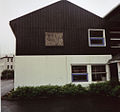Vestmanna
Vestmanna ( Danish : Vestmannahavn , German meaning: "Westmänner (harbor)") is the second largest city on Streymoy , the main island of the Faroe Islands , after Tórshavn . At the beginning of 2016 Vestmanna had 1,209 inhabitants. The Faroese municipality of the same name is the seventh largest in the archipelago. The postal code of Vestmanna is FO-350.
Origin of name
The name Vestmanna appears in written documents for the first time around 1350 to 1400 in the Old Norse form "í Vestmannahøfn" . The name suggests that the place was inhabited by settlers who came from the west , i.e. western men . The term Western men was not sharply defined in the Viking Age; it was a general term for people from western areas. This could be the Irish , who are said to have settled first in the Faroe Islands, or the Vikings who already settled in Ireland and Scotland and then moved to the Faroe Islands in the second wave of landings at the end of the 10th century.
In Jarðarbókin from 1584 the place is listed under the Danish name Vesmennde Haffnn .
Geography and traffic
Vestmanna is located on the west coast of Streymoy and has a seaport that is considered one of the best natural harbors in the Faroe Islands. For decades, the pier for the car ferry to Vágar was important there .
The Vágar tunnel , which is subject to charges , has existed since December 2002 and connects the main island (and thus the capital Tórshavn) from Leynar to the airport on Vágar. The ferry connection was therefore discontinued.
Economic history
Vestmanna became important in 1839 when the Royal Danish Monopoly Trade opened a branch there to serve the north of Streymoy and Vágar. Back then, the goods were transported on the mountain trails by rowing boats or on foot.
In 1897 the shipyard was built here, primarily to repair the fishing trawlers that were then bought in Great Britain . Today this shipyard belongs to the Tórshavner shipyard.
In 1950 the Faroe Islands' largest hydroelectric power station was built in Vestmanna . For this purpose, the water dammed up in the mountains is conveyed with pipes laid above ground into the turbines located below in Vestmanna. By 1986 , 80% of the Faroe Islands' hydropower was generated here.
In 1956 the branch of Færø Amts Sparekasse was opened.
There are a total of three power plants with four machines in Vestmanna. Two machines in Fossaverkid and one each in Heygaverkid and Myraverkid. The total installed capacity is around 13.7 MW.
Tourism and sightseeing
From there, boat tours to the gigantic cliffs on the northwest coast of Streymoy are organized. The best time for this is June and July, when millions of breeding birds populate the Faroe Islands.
In addition to the cliffs, there are a large number of natural grottos on this rocky coast , which you can also drive into if the waves allow it. Alternatively, fishing tours are offered.
A historic hiking trail leads from Vestmanna over the mountains to Saksun (18 km). This tour is challenging and should be carefully prepared. The paved road to Vestmanna leads west out of the village and ends near a lake area in the wilderness. In Vestmanna itself, at the mouth of the Gjógvará stream in the center of the village, sparse remains of buildings from the Viking Age have been discovered. But you don't see any excavations at the site, and there is no sign. In the northern part of the village, a small park with walking paths and benches was created on the same stream, in which whale ribs were used to delimit some of the paths.
In another small green area in the south of the city you can see the 2.2 m high bronze statue "Útróðrarmaðurin", which was created in 1961 by Janus Kamban , one of the most important artists of the Faroe Islands. He also made the 1.2 × 1.4 m large basalt relief "Móðurmálið" at the school.
The bird cliffs Vestmannabjørgini north of Vestmanna are famous .
Pictures from Vestmanna
Bronze statue "Útróðrarmaðurin" (1961) by Janus Kamban .
Relief "Móðurmálið" by Janus Kamban at the school in Vestmanna
Personalities
- Marianna Debes Dahl (* 1947), Faroese writer
- Astrid Andreasen (* 1948), Faroese textile and drawing artist
- Bárður Nielsen (* 1972), Faroese politician, chairman of the Sambandsflokkurin .
See also
- List of cities and towns in the Faroe Islands , List of municipalities in the Faroe Islands
- Faroese bird life
Web links
- Faroeislands.dk: Vestmanna (in English, info. And photos)
- Vestmanna.fo - Official homepage (in Faroese)
- Skúvadal - provider of boat tours to the bird cliffs (in German, photos, videos)
- Palli Lamhauge - Another provider of boat tours (in English, many photos)
- Vestmanna School (including English pages)
- Fisheries College (in Faroese)
Individual evidence
- ↑ Fólkatalsbroytingar skiftar á fødd, deyð, flutt og bygd, mánaðarliga (1985-2016) , hagstova.fo
- ^ GVC Young: From the Vikings to the Reformation - A Chronicle of the Faroe Islands Up to 1538 , Shearwater Press, Douglas, Isle of Man 1979
- ↑ Hvussu gomul er bygdin , heimabeiti.fo (in Faroese)
- ↑ Um Vestmanna , snar.fo (in Faroese)
- ↑ The Jarðarbókin 1584 is the oldest surviving register of royal estates on the Faroe Islands ( Jarðarbókin 1584 )
- ↑ On page 40: Vesmennde Haffnn
- ↑ Marianna Debes Dahl (1947 -) , kvinfo.dk
Coordinates: 62 ° 9 ′ N , 7 ° 10 ′ W








